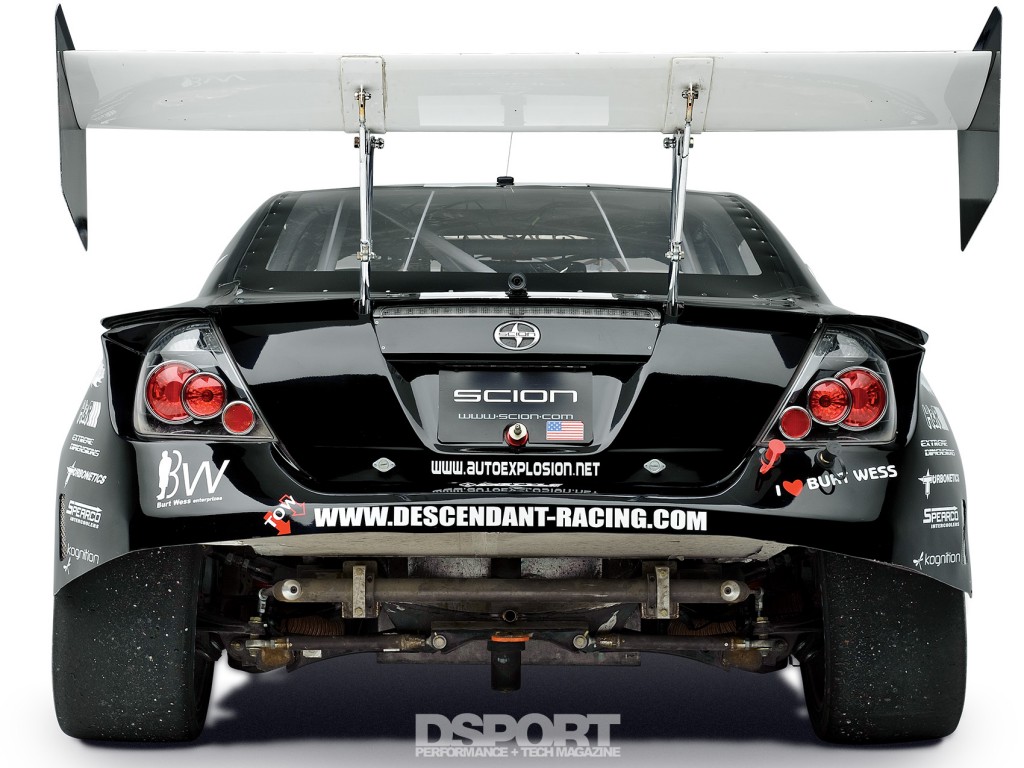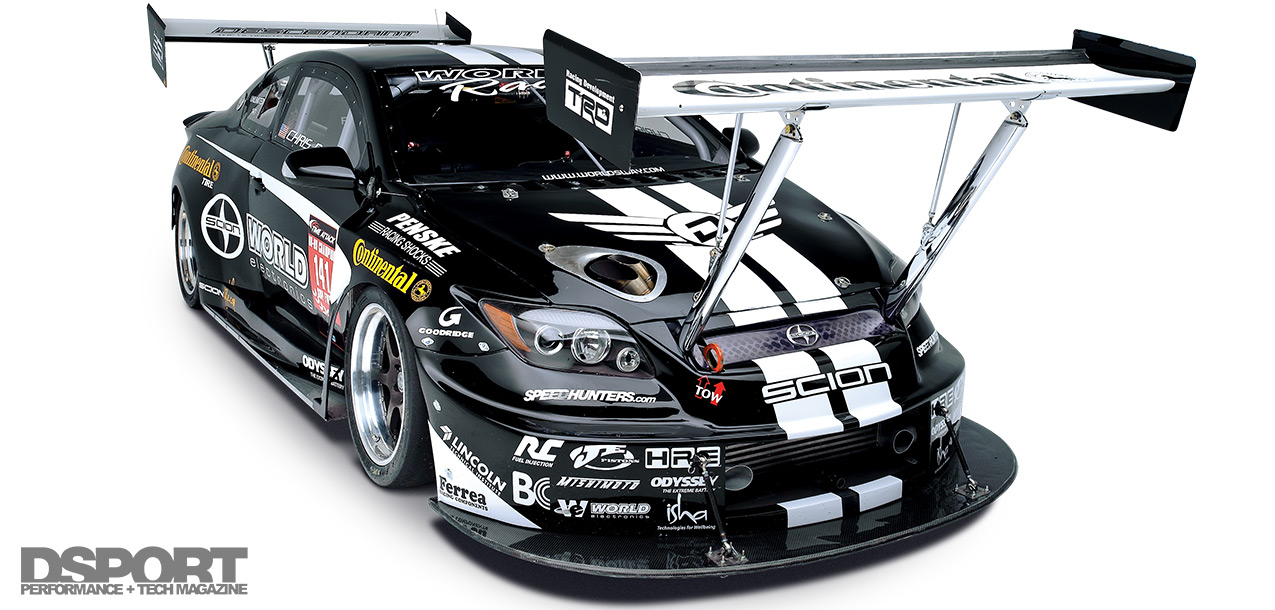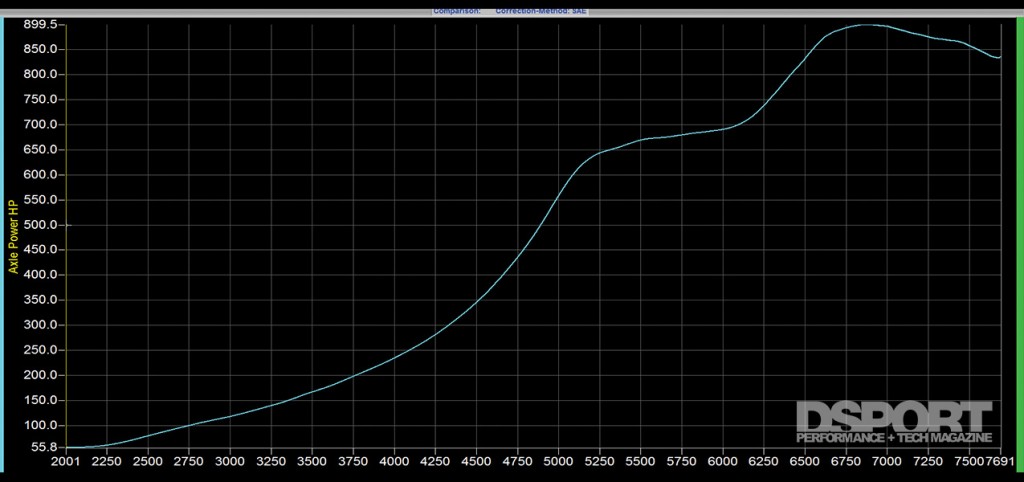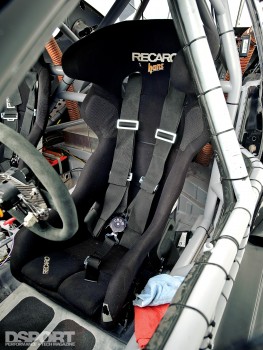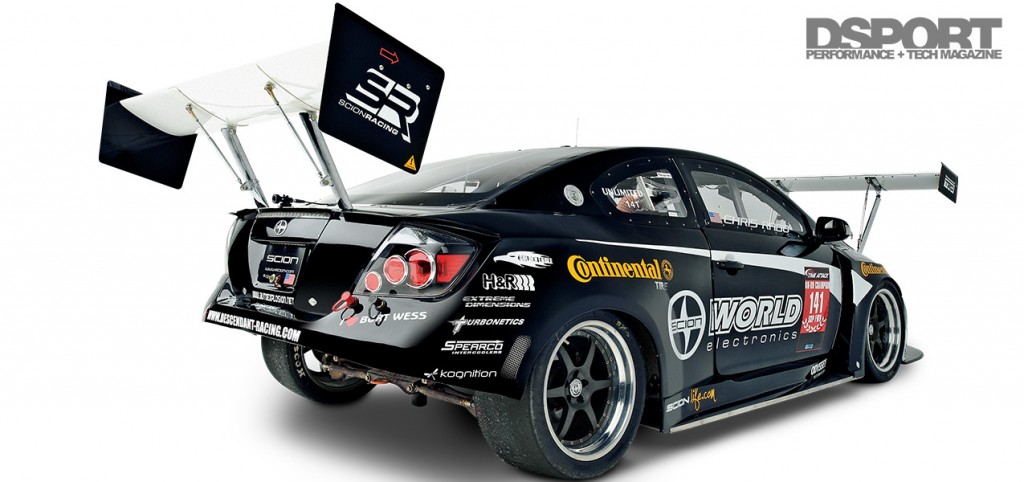Stepping Up To Greatness
The first year, the tC was set up with a basic suspension, eight-inch wide wheels, street tires and a turbo system making 300 horsepower. Shortly after, larger wheels, wider tires, more boost and bigger brakes followed. At the start of 2008, horsepower was up to 500-550 and by the end of the year, was making 700 horsepower. The tC won in its class at every event it attended in ‘08, but not without growing pains.
Starvin’ Sump
The development of the 2AZ-FE engine included knowledge gained from the World Racing drag tC. As Rado honed his road course skills, additional power was needed to continue the climb to the top. Early on, hard lessons were learned about the effects of high g-force loads. During hard cornering, the oil would slosh away from the oil pickup, subsequently starving the engine of oil, resulting in spun bearings and bent rods. These oil deficient conditions claimed several engines throughout the season. The ultimate solution was quite simple. A Canton Racing Products Accusump oil accumulator was plumbed into the engine, providing supplemental oil to combat oil pressure drops on the track.
The Quickest Way From A to Z
With oil starvation issues addressed, focus shifted back to making power from the 2AZ-FE engine. Incredibly, the factory aluminum block with factory cylinder sleeves has survived the higher cylinder pressures of forced induction. Gary Kubo, World Racing’s chief mechanic and engine builder, mentioned that development time was limited, since the team was constantly on the road, preparing for each event with seemingly little time for development. The majority of the time was spent repairing or remedying issues uncovered after each race. This meant exotic parts were out of the question. Today, World Racing builds its competition 2AZ-FE engines with OEM Toyota components and production components from the automotive aftermarket (including World Racing’s Descendant product line). Hence, the engine setup in this tC can be duplicated without custom-made parts.
F’wing Of Fancy
In May of 2009, the team embraced the revolutionary and one-of-a-kind front wing or “f’wing”. Time attack crew chief Ron Mathis analyzed the datalogs and too much of the additional horsepower was being lost to tire spin. A Boeing engineer that consults for World Racing designed the front-mounted wing for the tC. Rado states that the f’wing delivers 1,500 pounds of downforce over the front of the car, helping to maximize traction for optimal handling and power delivery. Although the f’wing is unorthodox, the Super Modified or Unlimited class in time attack is unrestricted, which leaves open the opportunity to experiment with innovative ideas that would otherwise be banned or restricted from competition.
Who’s Knocking
 Larger diameter-rotors and high cornering loads can exacerbate the onset of pad knockback. Knockback occurs when high cornering forces cause the rotor to no longer remain parallel to the pistons in the caliper. As a result, the deflection of the brake rotor causes the pistons to be pushed back in the bores. After this knockback of the pistons occurs, the next application of the brakes wastes a major part of the travel just taking up the distance that the pistons were pushed back in their bores. Reducing the rotor deflection through increased suspension rigidity is one solution. On the tC, the solution included Camry V6 uprights machined to work with the tC lower control arms and the largest wheel bearings that would fit the assembly. A custom hub and dual A- arm suspension is in development to further stiffen the front suspension.
Larger diameter-rotors and high cornering loads can exacerbate the onset of pad knockback. Knockback occurs when high cornering forces cause the rotor to no longer remain parallel to the pistons in the caliper. As a result, the deflection of the brake rotor causes the pistons to be pushed back in the bores. After this knockback of the pistons occurs, the next application of the brakes wastes a major part of the travel just taking up the distance that the pistons were pushed back in their bores. Reducing the rotor deflection through increased suspension rigidity is one solution. On the tC, the solution included Camry V6 uprights machined to work with the tC lower control arms and the largest wheel bearings that would fit the assembly. A custom hub and dual A- arm suspension is in development to further stiffen the front suspension.
Rough Road To The Records
World Racing learned volumes and faced numerous challenges while road racing the tC. From blown engines and bent connecting rods to broken transmissions and braking issues, the limits of nearly every component had been identified. As the tC has been developed to be a better track car, Rado has developed himself to be a better track driver. [pullquote]BY INSTINCT I COUNTERSTEERED AND LET OFF THE GAS, WHEN IN FACT I SHOULD HAVE TURNED THE WHEEL WHERE I WANTED TO GO AND STAYED ON THE GAS.[/pullquote]He comments, “Coming from a RWD background, I had a few things to learn about FWD. For example, I started to lose the rear end, so by instinct I countersteered and let off the gas, when in fact I should have turned the wheel where I wanted to go and stayed on the gas. These are the lessons that are learned quickly and not forgotten.” With more seat time, aero testing and several engine builds, Rado’s team began capturing not only podiums but FWD track records. The day of reckoning was on November 11, 2009. At Buttonwillow, the World Racing tC ran a 1:49.703, beating Chevrolet’s standing record from 2005 by 1.615 seconds. But this wasn’t enough. In the off- season, more was extracted from the tC. At the Redline Time Attack season opener on March 28, 2010, not only did World Racing win in its class, it smashed its own FWD record with a 1:46.730 second lap time. Aspiration, innovation and failure lead to success, and this time-attack machine proves that hard work and perseverance certainly pays off. Among FWD time-attack machines, World Racing has no peers.